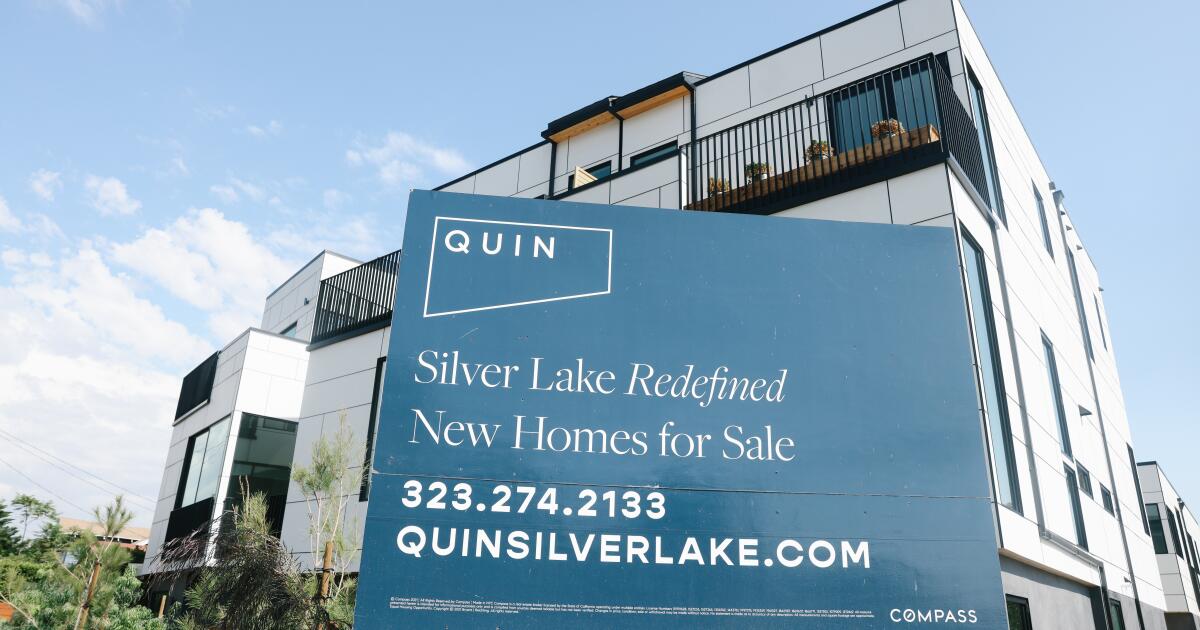
Southern California home prices hit a record in March amid sky-high mortgage interest rates, a combination that’s creating the most unaffordable housing market in a generation.
The average for the six-county region reached $869,082 in March, according to Zillow. That’s up 9% from a year earlier and 1% higher than the previous all-time high in June 2022.
With rates hovering in the upper 6% range, the mortgage payment on the average home now tops $5,500 — if you can put 20% down.
“It’s bananas,” Tommy Kotero, a 43-year-old refinery worker, said last weekend after touring a dated, $899,000 house in north Torrance with visible cracks in the ceiling and walls. “The asking prices for what we are getting is crazy.”
How home prices hit a record despite the high cost of borrowing is a tale of too few homes for sale, combined with a wealth gap that has equipped some buyers with reams of cash that negate the effect of high rates.
When interest rates first soared in 2022, buyers backed away en masse, inventory swelled and home prices dropped.
Then potential sellers all but went on strike, with many deciding they didn’t want to move and trade their sub-3% mortgages for a loan at more than double that rate.
Inventory plunged and enough buyers returned to send home prices back up. Many of these buyers are well-heeled first-timers who aren’t ditching a low-cost mortgage.
Others are holding on to their old home and buying another. Still more are selling their old home and turning their considerable equity into hefty down payments well over 20%.
“People who have cash are not paying too much attention to interest rates,” said Alin Glogovicean, a real estate agent with Redfin who specializes in northeast L.A.
He estimates that in about one-third of his deals a buyer is paying all cash. Another third put down at least 50%, with a mortgage on the rest.
At least two-thirds of the buyers with down payments of at least 30% aren’t investors but people who want to live in the home, he said. They are professionals such as architects and Hollywood types who have saved, liquidated stock portfolios, built up equity or received help from family.
Some are willing to dip into retirement savings — a strategy many financial experts advise against.
Nationally, similar trends are afoot, according to a Zillow survey, with the share of home buyers putting at least 20% rising, as well as those who received help from family and friends.
In all, 23% of L.A. County homes sold in February were bought with all cash, up from 16% in 2021, according to Redfin.
For those without access to a spare half-a-mill, times are tougher.
According to the California Assn. of Realtors, only 11% of households in Los Angeles and Orange counties could reasonably afford the median-priced house during the fourth quarter, the smallest number since the housing bubble of the mid-aughts.
At that time, risky lending practices allowed people to buy homes they couldn’t really pay for. Today, lending standards are far tighter, which economists say should prevent a similar collapse in prices if there’s another recession.
Across the region, home prices have now set records in Orange, San Bernardino, San Diego and Ventura counties. In Los Angeles and Riverside counties, prices are less than 1% from their all-time highs.
Agent Alicia Fombona of United Real Estate Pacific States works across the Southland — from the coast to the Inland Empire. Amid high rates and high prices, she said, one strategy that’s growing more popular is co-borrowing: family and friends coming together to buy a house or duplex to keep payments somewhat affordable.
“Everybody needs a place to live and there is not enough housing for everybody,” Fombona said.
More homes are starting to come onto the market, but inventory is still tight and expected to remain so, according to forecasters. Rates may drop somewhat but are expected to remain elevated.
That combination could create a scenario in which prices don’t soar but also don’t drop much — if at all, especially because incomes for many households are growing.
“We are going to continue to see robust price growth, but nothing near where we were in the pandemic,” said Orphe Divounguy, a senior economist with Zillow.
If rates fell considerably, it would immediately make homes more affordable, but a new crop of buyers probably would flood the market and could put even more upward pressure on prices.
To help housing truly become more affordable, Divounguy said, there must be continued income growth and more housing construction.
“The way out of this is not going to come from mortgage rates,” he said.
In California, construction headed in the wrong direction in 2023, with building permits falling from the previous year, though lately there are signs of a rebound in single-family construction, which is mostly for-sale homes.
Some Californians, however, are on a timeline.
Kotero, the buyer looking in Torrance, currently rents a house in the city with his wife, Rikah, and their four children. But he said they need to find a new place by summer because the landlord is moving back in.
They’d like to buy and stay in Torrance for the schools but so far have struck out — even though Kotero makes $160,000 as a manager at a local oil refinery.
He said he and his wife were recently outbid, despite stretching their budget to offer $1 million for a house listed for $900,000.
Unlike others, the Koteros don’t have hundreds of thousands in cash to meaningfully offset high rates. Instead, Rikah, who currently stays home with the children, is thinking of looking for a job.
“If we are realistically looking to buy a home in Torrance, there’s no way around it,” Kotero said.
More to Read
- SEO Powered Content & PR Distribution. Get Amplified Today.
- PlatoData.Network Vertical Generative Ai. Empower Yourself. Access Here.
- PlatoAiStream. Web3 Intelligence. Knowledge Amplified. Access Here.
- PlatoESG. Carbon, CleanTech, Energy, Environment, Solar, Waste Management. Access Here.
- PlatoHealth. Biotech and Clinical Trials Intelligence. Access Here.
- Source: https://www.latimes.com/homeless-housing/story/2024-04-11/all-cash-offers-wealthy-buyers-push-southern-california-home-prices-to-a-record
- :has
- :is
- :not
- :where
- $1 million
- $899
- $UP
- 000
- 2021
- 2022
- 2023
- 5
- 500
- a
- About
- access
- According
- across
- advise
- affordable
- After
- against
- Agent
- alin
- All
- all-time highs
- allowed
- also
- Amid
- and
- Angeles
- Another
- architects
- ARE
- around
- AS
- asking
- At
- attention
- average
- away
- back
- backed
- BE
- because
- become
- Borrowing
- bought
- bubble
- budget
- Building
- built
- but
- buy
- BUYER..
- buyers
- Buying
- by
- california
- CAN
- Cash
- ceiling
- Children
- City
- Coast
- Collapse
- combination
- combined
- come
- coming
- considerable
- considerably
- construction
- continue
- continued
- Cost
- could
- county
- crazy
- create
- Creating
- crop
- Currently
- dated
- Deals
- Deciding
- Despite
- Diego
- Dip
- Dont
- double
- down
- Drop
- dropped
- during
- Earlier
- Economist
- economists
- effect
- elevated
- Empire
- enhancement
- enough
- equipped
- equity
- especially
- estate
- estimates
- Even
- everybody
- expected
- experts
- Falling
- family
- far
- February
- few
- financial
- Find
- First
- flood
- For
- four
- Fourth
- friends
- from
- gap
- generation
- getting
- going
- Growing
- Growth
- Have
- he
- headed
- hefty
- help
- High
- higher
- Highs
- his
- Hit
- holding
- Hollywood
- Home
- Homes
- House
- households
- housing
- However
- HTTPS
- if
- immediately
- in
- Income
- inland
- instead
- interest
- Interest Rates
- into
- inventory
- Investors
- IT
- Job
- jpg
- june
- Keep
- landlord
- Last
- lately
- least
- lending
- less
- like
- LINK
- LIQUIDATED
- List
- Listed
- live
- loan
- local
- looking
- los
- Los Angeles
- low-cost
- make
- MAKES
- manager
- many
- March
- Market
- masse
- May..
- million
- more
- Mortgage
- Mortgages
- most
- mostly
- move
- moving
- much
- must
- Near
- Need
- needs
- New
- no
- North
- nothing
- now
- number
- of
- offer
- Offers
- offset
- Oil
- Old
- on
- ONE
- One-third
- only
- onto
- or
- Orange
- Others
- out
- outbid
- over
- Pacific
- pandemic
- Pay
- paying
- payments
- People
- permits
- Place
- plato
- Plato Data Intelligence
- PlatoData
- plunged
- Popular
- portfolios
- potential
- practices
- pressure
- prevent
- previous
- price
- Prices
- probably
- professionals
- Push
- put
- Putting
- Quarter
- range
- Rate
- Rates
- reached
- real
- real estate
- really
- rebound
- received
- recently
- recession
- record
- records
- Redfin
- region
- remain
- REST
- retirement
- rising
- Risky
- Riverside
- robust
- Said
- sale
- San
- San Diego
- saved
- Savings
- say
- scenario
- Schools
- see
- Sellers
- Selling
- send
- senior
- set
- Share
- she
- should
- Signs
- similar
- since
- smallest
- So
- so Far
- soar
- soared
- sold
- some
- somewhat
- Southern
- specializes
- standards
- Starting
- States
- stay
- stays
- Still
- stock
- Strategy
- strike
- such
- summer
- Survey
- tale
- than
- that
- The
- their
- There.
- These
- they
- Thinking
- Third
- this
- those
- though?
- tighter
- time
- timeline
- times
- to
- today
- together
- too
- Tops
- touring
- trade
- Trends
- truly
- Turning
- two-thirds
- types
- United
- upward
- visible
- want
- Way..
- we
- Wealth
- wealthy
- weekend
- WELL
- went
- were
- What
- which
- WHO
- wife
- willing
- with
- without
- worker
- works
- would
- year
- you
- zephyrnet
- Zillow












